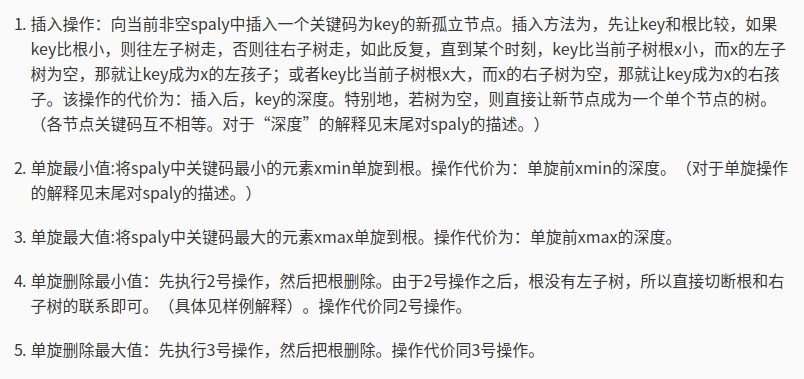题意:
模拟一棵单旋splay,支持五种操作

( ext{Solution:})
显然不是让你码一颗单旋splay(一条链卡爆你)。
在草稿纸上画一画,模拟一遍,观察中序遍历下的深度变化,发现当x为最小值时它没有左儿子,可能有右儿子,splay到根后除了它的右儿子深度不变,其余的深度都+1,x为最大值时同理。
因此,每次操作我们都可以用线段树直接维护深度,接下来要解决的问题就是怎么插入。
二叉搜索树一个点总是插在其前驱的右儿子或是后继的左儿子
所以我们只要找到它前驱或后继,然后接在它的下面,这个过程很容易用set实现,还要记录每个点的左儿子以及右儿子是谁,不然无法判断插入到前驱和后继哪个下面去。
( ext{Source})
// luogu-judger-enable-o2
#include <set>
#include <cmath>
#include <cstdio>
#include <cstring>
#include <iostream>
#include <assert.h>
#include <algorithm>
using namespace std;
#define LL long long
#define debug(...) fprintf(stderr, __VA_ARGS__)
#define GO debug("GO
")
inline int rint() {
register int x = 0, f = 1; register char c;
while (!isdigit(c = getchar())) if (c == '-') f = -1;
while (x = (x << 1) + (x << 3) + (c ^ 48), isdigit(c = getchar()));
return x * f;
}
template<typename T> inline void chkmin(T &a, T b) { a > b ? a = b : 0; }
template<typename T> inline void chkmax(T &a, T b) { a < b ? a = b : 0; }
const int N = 1e5 + 10;
#define Iter set<int>::iterator
set<int> S;
int a[N], tot, ch[N][2], fa[N], m, op[N], buc[N], root; int dep[N<<2];
void add(int x, int l, int r, int L, int R, int val) {
if (L <= l and r <= R) {
dep[x] += val;
return;
}
int mid = (l + r) >> 1;
if (L <= mid) add(x<<1, l, mid, L, R, val);
if (mid < R) add(x<<1|1, mid + 1, r, L, R, val);
}
int query(int x, int l, int r, int p) {
if (l == r) {
return dep[x];
}
int mid = (l + r) >> 1;
if (p <= mid) return dep[x] + query(x<<1, l, mid, p);
else return dep[x] + query(x<<1|1, mid+1, r, p);
}
void change(int x, int y) {
add(1, 1, tot, x, x, y - query(1, 1, tot, x));
}
int Insert(int x) {
Iter it = S.insert(x).first;
if (root == 0) {
root = x;
change(x, 1);
return 1;
}
if (it != S.begin()) {
if (ch[*--it][1] == 0) ch[fa[x] = *it][1] = x;
it++;
}
if (fa[x] == 0) ch[fa[x] = *++it][0] = x;
int res = query(1, 1, tot, fa[x]) + 1;
change(x, res);
return res;
}
int findmin() {
int x = *S.begin(), res = query(1, 1, tot, x);
if (x == root) return 1;
if (x + 1 <= fa[x] - 1)
add(1, 1, tot, x + 1, fa[x] - 1, -1);
add(1, 1, tot, 1, tot, 1);
ch[fa[x]][0] = ch[x][1], fa[ch[x][1]] = fa[x];
fa[root] = x, ch[x][1] = root;
root = x;
change(x, 1);
return res;
}
int findmax() {
int x = *S.rbegin(), res = query(1, 1, tot, x);
if (x == root) return 1;
if (x - 1 >= fa[x] + 1)
add(1, 1, tot, fa[x] + 1, x - 1, -1);
add(1, 1, tot, 1, tot, 1);
ch[fa[x]][1] = ch[x][0], fa[ch[x][0]] = fa[x];
fa[root] = x, ch[x][0] = root;
root = x;
change(x, 1);
return res;
}
void delmin() {
printf("%d
", findmin());
add(1, 1, tot, 1, tot, -1);
S.erase(root);
root = ch[root][1];
fa[root] = 0;
}
void delmax() {
printf("%d
", findmax());
add(1, 1, tot, 1, tot, -1);
S.erase(root);
root = ch[root][0];
fa[root] = 0;
}
int main() {
#ifndef ONLINE_JUDGE
freopen("xhc.in", "r", stdin);
freopen("xhc.out", "w", stdout);
#endif
m = rint();
for (int i = 1; i <= m; ++ i) {
op[i] = rint();
if (op[i] == 1) {
tot++;
a[tot] = buc[tot] = rint();
}
}
sort(buc + 1, buc + 1 + tot);
for (int i = 1; i <= tot; ++ i)
a[i] = lower_bound(buc + 1, buc + 1 + tot, a[i]) - buc;
for (int i = 1, cnt = 0; i <= m; ++ i) {
switch(op[i]) {
case 1: printf("%d
", Insert(a[++cnt])); break;
case 2: printf("%d
", findmin()); break;
case 3: printf("%d
", findmax()); break;
case 4: delmin(); break;
case 5: delmax(); break;
}
}
}